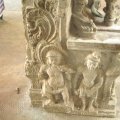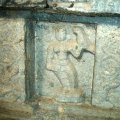Sculptures in temples in Kumbakonam: photo 465
Photo 465 of 640 in Gallery: Sculptures in temples in Kumbakonam

Image title: Figure 13. Two male figures playing Nadaswaram
Description of the photo
Two male figures playing Nadaswaram. Figure on left–Feet in Sama but both are turned to his right. The Udara is in Ksama i.e. as if exhaling. His hands are holding the Nadaswaram. This figure is in Dvibhanga posture. Siras is in Nihancita. Ganda are Phulla or Purna (since he is playing the Nadaswaram).The second figure–Siras is in Nihancita, Ganda are Purna, Urah is in Sama, Udara seems normal. On left side the Kati is raised in Udvahita, feet are again turned to right but in Sama. These are not dance postures and hence we cannot identify any Cari or Karana. It gives us a fair idea about the costume of the musicians and the musical instruments played during those times. Turbans seem to be popular for males.
Nadaswaram was a popular instrument played in the temples during all festivals and processions. Nadaswaram generally is known to have elevating effect and hence most of the South Indian temples have playing of the Nadaswaram.The deity in procession would be accompanied by drums, Nadaswaram, Tavil, Flute, Vina cymbals etc. Nadaswaram is a wind instrument and requires the use of lungs and wind pipe. Hence we can see the full blown cheeks to fill air.
Gallery information:
Kumbakonam is considered as one of the holiest places in Tamil Nadu and is known for its temples and Mathas (monasteries which were centres of Brahmanical learning). These photographs depict the connection between the sculptures in the temples and Natya Shastra and related texts dealing with iconography.
Photo details:
High resolution:
Download file
Size: 71.71 KB
Resolution: 784 x 588
© Copyright: see gallery source

